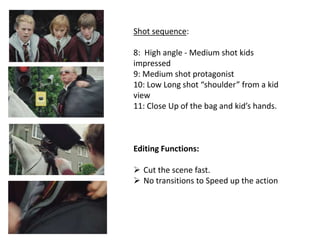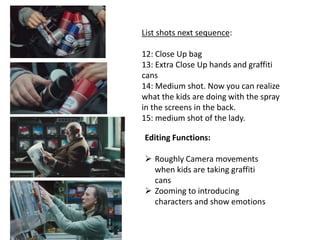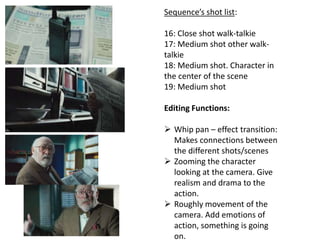Hot fuzz clip
- 1. EDITING ANALYSIS OF HOT FUZZ CLIP The scene starts showing the main character. 1: Long shot 2: Medium shot 3: Close shot Editing Function: Action movement INTRODUCTION main character, every second more approached Black transition between shots Intrigue audience
- 2. The next shots sequence: 4: High angle - Long shot. Group of kids surprised from point of view of the protagonist. 5: Low Long shot “shoulder” from a kid view 6: Low Angle-medium shot. Showing the protagonist & kids. 7: Medium shot. Now you can tell the shot before was from the security camera where the protagonist was looking at. Editing Functions: Cut the scene fast. Speed up action
- 3. Shot sequence: 8: High angle - Medium shot kids impressed 9: Medium shot protagonist 10: Low Long shot “shoulder” from a kid view 11: Close Up of the bag and kid’s hands. Editing Functions: Cut the scene fast. No transitions to Speed up the action
- 4. List shots next sequence: 12: Close Up bag 13: Extra Close Up hands and graffiti cans 14: Medium shot. Now you can realize what the kids are doing with the spray in the screens in the back. 15: medium shot of the lady. Editing Functions: Roughly Camera movements when kids are taking graffiti cans Zooming to introducing characters and show emotions
- 5. Sequence’s shot list: 16: Close shot walk-talkie 17: Medium shot other walk- talkie 18: Medium shot. Character in the center of the scene 19: Medium shot Editing Functions: Whip pan – effect transition: Makes connections between the different shots/scenes Zooming the character looking at the camera. Give realism and drama to the action. Roughly movement of the camera. Add emotions of action, something is going on.




